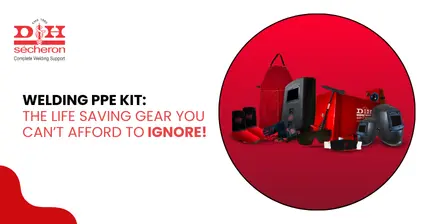
Welding is a crucial process across various industries that impacts the longevity and strength of the final products. The heart of the welding process is a welding electrode. Choosing the right welding electrode can be said to be a substantial decision.
Let us explore various types of electrodes, their uses, and key considerations so you can select the one that best fits your needs.
What is a welding electrode?
In simple terms, a welding electrode is a metallic rod or wire that conducts currents from the welding machine to the workpiece. It melts to form the weld. Apart from this, a welding rod can also serve as filler material that joins two pieces of metal together.
An electrode can be a consumable or a non-consumable depending on the welding process. Consumable electrodes melt during the process to provide filler materials. On the other hand, non-consumable electrodes don’t melt but can still conduct electricity required to create a weld.
The importance of choosing the correct electrode
Some of the key reasons why choosing the right welding electrode is necessary are:
1. Welding Position: Depending on their designs, some welding electrodes are more suitable for flat positions whereas some are more suitable for overhead or vertical welding.
2. Base material: The material composition you are welding will affect the choice of electrode. For instance, aluminium welding rods are designed specifically for joining aluminium materials.
3. Required Weld Strength: Different electrodes have different tensile strengths. Their tensile strength determines the strength of the finished weld.
4. Environmental Conditions: Environmental conditions can affect the welding. For example, a weld in a damp area has to be water-resistant.
Using the wrong type of electrode can lead to weaker welds, defects in welds, or even safety hazards.
Some common types of welding electrodes
Shielded Metal Arc Welding (SMAW) Electrodes
SMAW electrodes are also known as stick electrodes. They are popular for their versatility and easy-to-use quality. They are great options for fabrication, maintenance and repair work.
Common types of SMAW electrodes include:
a. E6010: Used for deep penetration, especially in rusty and dirty metals.
b. E6013: A good choice for cleaner metals. They provide a smooth and easy arc.
c. E7018: It has high tensile strength and low hydrogen content. This makes it the top choice for structural welding projects.
Tungsten Inert Gas (TIG) Electrodes
This non-consumable electrode is made from tungsten. It is typically used in precision welding and produces clean and high-quality welds. TIG welding needs highly skilled labour.
Metal Inert Gas (MIG) Electrodes
MIG electrodes are consumable and fed through a welding gun. It is fast and efficient, and mostly used for fabrications and automotive repairs.
Submerged Arc Welding (SAW) Electrodes
SAW electrodes are used in environments where large scale productions are done, such as shipbuilding. They are used in a continuously fed wire and create a clean weld perfect for thick materials.
At D&H Sécheron, we believe in making things that last and serve the purpose behind their making to the best level. A welding electrode is a crucial element in this. Selecting the right welding electrode whether it's for a stick welding machine or TIG welding requires careful consideration. You can connect with our experts for specialised guidance and support for your welding projects to be a success!
11 May 2025 | Welding
An In-Depth Exploration of Low-Alloy Steel: Your Comprehensive Guide
11 May 2025 | Welding
Nagpur - Bori - Tuljapur Road MSH-3 in Yavatmal District (Maharashtra)
11 May 2025 | Welding
Guidelines to Understand Gas Welding: Applications, Advantages & Disadvantages
11 May 2025 | Welding
3 Tips for Finding the Best Mild Steel Electrode for Your Application
11 May 2025 | Welding
How to Select the Right Welding Filler Wires for Stainless Steel Welding?
11 May 2025 | Welding
Building the Narendra Modi Stadium with Norma V and Autotherme-1 Electrodes
11 May 2025 | Welding
Low Alloy Steel Welding in a (PEB) Pre Engineered Building Structure
11 May 2025 | Welding
Welding Rods: Different Types and Tips for Properly Storing and Handling
11 May 2025 | Welding
Tips for Flawless Welds with Stainless Steel Electrodes: Pros and Cons
11 May 2025 | Welding
Exploring Applications and Benefits of Stainless Steel Welding Electrodes
11 May 2025 | Welding
Welding Basics: Joining Metals with Heat and Pressure - A Beginners Guide
11 May 2025 | Welding
Distinguishing Low-Alloy Steel from High-Alloy Steel: Understanding the Variations
11 May 2025 | Welding
Hard Facing Wire - Understanding the Process and Achieving Optimal Result
11 May 2025 | Welding
Exploring the Advantages of Stainless Steel Electrodes in Welding Applications
11 May 2025 | Welding
Weathering Steel vs. Traditional Steel: A Comparative Analysis of Performance
11 May 2025 | Welding
Choosing the Right Welding Rod: Why 6013 Electrodes Might Be Your Ideal Option
11 May 2025 | Welding
Why 7018 Electrodes Are Preferred for High-Strength Welds in Pipeline Construction
11 May 2025 | Welding
Filler Wire vs. Stainless Steel Filler Wire: Understanding the Key Differences
11 May 2025 | Welding
Exploring the Impact of Filler Material on Welding Quality and Durability
11 May 2025 | Welding
Choosing the Right Cast Iron Electrode for Different Welding Projects
11 May 2025 | Welding
Top Advantages of Cast Iron Electrodes for Industrial Welding Applications
11 May 2025 | Welding
Key Benefits and Challenges of Using TIG Welding in Industrial Projects
11 May 2025 | Welding
5 Reasons Why 7018 Electrode is the Gold Standard for Welding Professionals
11 May 2025 | Welding
Top 5 Advantages of Flux Cored Arc Welding for Heavy-Duty Applications.png)
11 May 2025 | Welding
Lotherme-601: A Game-Changer for Restoring Shoulder Pins in Heavy Machinery
11 May 2025 | Welding
How D&H Sécheron Helped Repair a Rotary Kiln’s Cooler Section with LoTherme 352
11 May 2025 | Welding
Piston Repair for Mining Industry: Cost-Effective Solutions with LoTherme 468.webp)






.jpg)








































.jpg)
.jpg)

.jpg)

.jpg)





.jpg)
.jpg)
.jpg)



.webp)
.jpg)
.jpg)
.webp)
.jpg)






















.png)



.webp)

.webp)
.webp)



